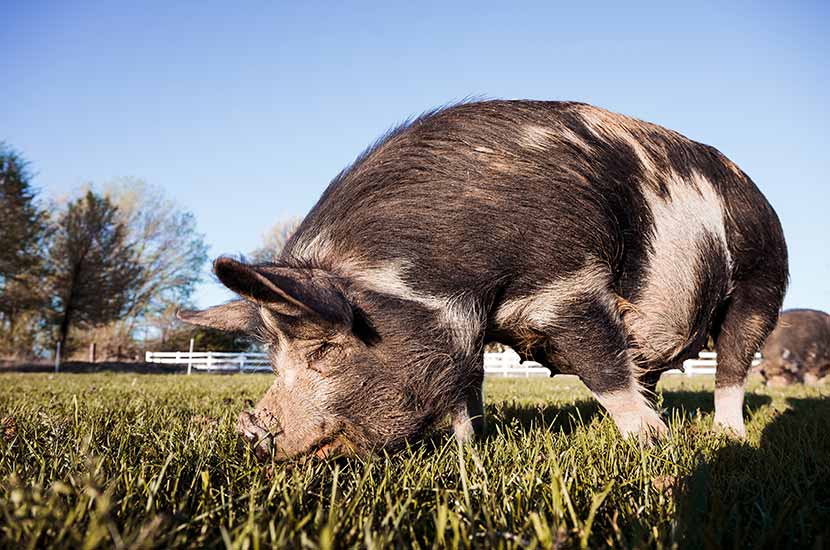Swine erysipelas is caused by a bacterium, Erysipelothrix rhusiopathiae. This infection gets its name from the diamond patches on the skin that occur as a result of the bacteria. Pigs and turkeys are most commonly affected, but cases have been reported in other birds, sheep, fish, and reptiles.
On pig farms, and it is thought that up to 50% of the swine population may carry it. This is because recovered pigs and chronically infected pigs may become carriers of E rhusiopathiae and because healthy swine also may be asymptomatic carriers. Since it is thought that it is always present in either the pig or in the environment as saliva, feces, or urine, it is impossible to eliminate it from a herd. While just the bacteria is sufficient to cause the diamond skin disease, it is also thought that infections with other viruses like PRRS and influenza can trigger the outbreak. When pigs are younger than about 12 weeks of age, they are protected by antibodies from the mother which they get in their mother’s milk (colostrum). Older pigs tend to develop protective immunity as a result of exposure to serotypes that do not cause clinical disease. As a result, the most susceptible pigs to this disease are growing pigs that are not yet vaccinated against diamond skin disease.
Erysipelas infections occur when the organism is ingested through the environmental contamination and multiplies in the body. The bacteria then travels in the bloodstream to other sites, causing a septicemia (a widespread infection through the blood). The bacteria can go to the skin, where it causes blockage of small blood vessels. Because of the restricted blood supply, the skin does not get enough oxygen and slowly dies. The skin initially becomes a raised reddened diamond area that ultimately turns black due to the dead tissue.
Depending on how quickly this occurs and how quickly the body responds to the infection, this outcome for the pig changes. The speed of the body’s reaction determines the clinical symptoms a pig presents with. Pigs that experience peracute or acute disease oftentimes do not have clinical signs except death, which occurs from septicemia or heart failure. Other times, a fever and general signs of infection are present. With a pig experiencing subacute disease, signs may include inappetence, infertility, fever, diamond skin lesions, necrosis and sloughing of the tips of the ears and tail, and in pregnant females this disease can cause stillbirths, mummified piglets, and abortions. In chronic disease, the organism causes far fewer deaths and can either affect the joints causing a marked lameness or cause problems with the heart and the valves of the heart where bacterial colonies attach and may scatter into the bloodstream at any time. Pigs with valvular lesions may exhibit few clinical signs; however, when exerted physically they may show signs of respiratory distress and possibly succumb to the infection. Boars typically develop fevers and the sperm count can be negatively affected for the complete development period of 5-6 weeks.
Some things that may contribute or cause these infections are as follows: dirty pens, no all-in all-out procedures or disinfection protocols, contaminated water source, movement or transport of pigs which can increase their stress level and make them susceptible to infections, sudden changes in diet or temperature, wet feeding systems particularly if milk products are used, and feedback of feces.
The diagnosis of erysipelas is based on clinical signs, gross lesions, and response to antimicrobial therapy. Acute erysipelas can be difficult to diagnose in individual pigs showing only fever, poor appetite, and listlessness. However, in outbreaks involving several animals, the presence of skin lesions and lameness is likely to be seen in at least some cases and would support a clinical diagnosis. Diamond skin lesions are diagnostic when present. A PCR test, if available, augments the diagnosis of acute erysipelas, or complement fixation texts may be done.
E rhusiopathiae can be treated effectively with penicillin. Ideally, affected pigs should be treated twice daily for a minimum of 3 days, although longer durations of therapy may be necessary to resolve severe infections. Fever associated with acute infections can be managed by administration of NSAID such as flunixin meglumine or by delivery of aspirin in the water.
To prevent an outbreak from ever happening, a vaccination against E rhusiopathiae is very important. Injectable bacterins and attenuated, live vaccines delivered via the water are available and provide extended duration of immunity. When E rhusiopathiae is endemic in the production environment, vaccination should precede anticipated outbreaks. Susceptible pigs may be vaccinated prior to weaning, at weaning, or several weeks post-weaning. Male and female swine selected for addition to the breeding herd should be vaccinated, with a booster 3–5 wk later. Thereafter, breeding stock should be vaccinated twice yearly. Vaccines should not be administered to animals undergoing antibiotic therapy because antibiotics can interfere with the subsequent immune response to the vaccine.
Works CitedRagland, Darryl. “Swine Erysipelas.” March 2012. The Merck Veterinary Manual. 4 March 2015.

